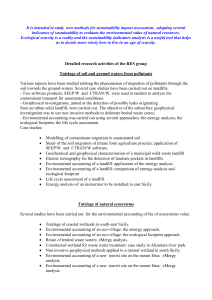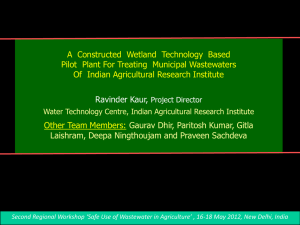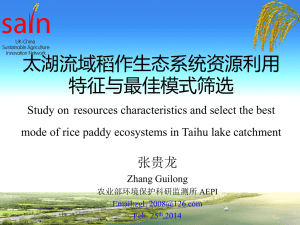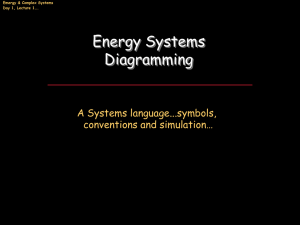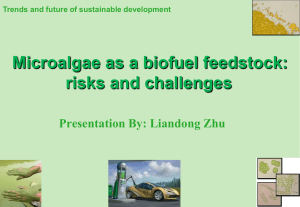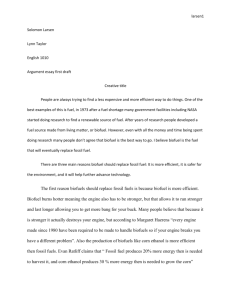Overview - United States Association for Energy Economics
advertisement
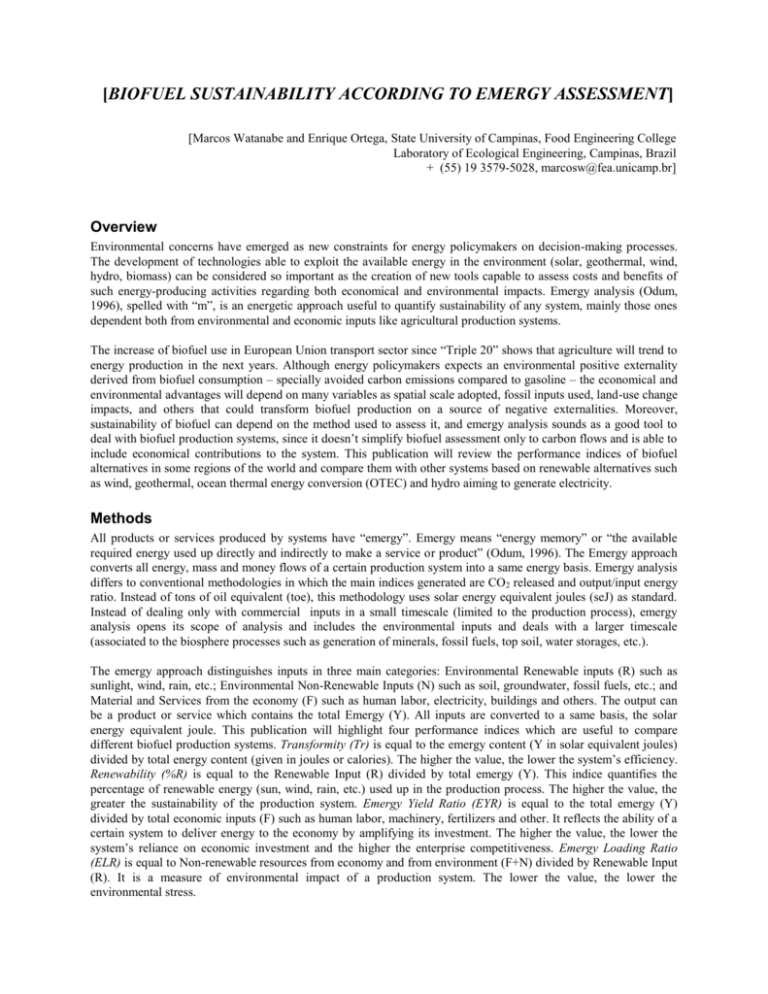
[BIOFUEL SUSTAINABILITY ACCORDING TO EMERGY ASSESSMENT] [Marcos Watanabe and Enrique Ortega, State University of Campinas, Food Engineering College Laboratory of Ecological Engineering, Campinas, Brazil + (55) 19 3579-5028, marcosw@fea.unicamp.br] Overview Environmental concerns have emerged as new constraints for energy policymakers on decision-making processes. The development of technologies able to exploit the available energy in the environment (solar, geothermal, wind, hydro, biomass) can be considered so important as the creation of new tools capable to assess costs and benefits of such energy-producing activities regarding both economical and environmental impacts. Emergy analysis (Odum, 1996), spelled with “m”, is an energetic approach useful to quantify sustainability of any system, mainly those ones dependent both from environmental and economic inputs like agricultural production systems. The increase of biofuel use in European Union transport sector since “Triple 20” shows that agriculture will trend to energy production in the next years. Although energy policymakers expects an environmental positive externality derived from biofuel consumption – specially avoided carbon emissions compared to gasoline – the economical and environmental advantages will depend on many variables as spatial scale adopted, fossil inputs used, land-use change impacts, and others that could transform biofuel production on a source of negative externalities. Moreover, sustainability of biofuel can depend on the method used to assess it, and emergy analysis sounds as a good tool to deal with biofuel production systems, since it doesn’t simplify biofuel assessment only to carbon flows and is able to include economical contributions to the system. This publication will review the performance indices of biofuel alternatives in some regions of the world and compare them with other systems based on renewable alternatives such as wind, geothermal, ocean thermal energy conversion (OTEC) and hydro aiming to generate electricity. Methods All products or services produced by systems have “emergy”. Emergy means “energy memory” or “the available required energy used up directly and indirectly to make a service or product” (Odum, 1996). The Emergy approach converts all energy, mass and money flows of a certain production system into a same energy basis. Emergy analysis differs to conventional methodologies in which the main indices generated are CO2 released and output/input energy ratio. Instead of tons of oil equivalent (toe), this methodology uses solar energy equivalent joules (seJ) as standard. Instead of dealing only with commercial inputs in a small timescale (limited to the production process), emergy analysis opens its scope of analysis and includes the environmental inputs and deals with a larger timescale (associated to the biosphere processes such as generation of minerals, fossil fuels, top soil, water storages, etc.). The emergy approach distinguishes inputs in three main categories: Environmental Renewable inputs (R) such as sunlight, wind, rain, etc.; Environmental Non-Renewable Inputs (N) such as soil, groundwater, fossil fuels, etc.; and Material and Services from the economy (F) such as human labor, electricity, buildings and others. The output can be a product or service which contains the total Emergy (Y). All inputs are converted to a same basis, the solar energy equivalent joule. This publication will highlight four performance indices which are useful to compare different biofuel production systems. Transformity (Tr) is equal to the emergy content (Y in solar equivalent joules) divided by total energy content (given in joules or calories). The higher the value, the lower the system’s efficiency. Renewability (%R) is equal to the Renewable Input (R) divided by total emergy (Y). This indice quantifies the percentage of renewable energy (sun, wind, rain, etc.) used up in the production process. The higher the value, the greater the sustainability of the production system. Emergy Yield Ratio (EYR) is equal to the total emergy (Y) divided by total economic inputs (F) such as human labor, machinery, fertilizers and other. It reflects the ability of a certain system to deliver energy to the economy by amplifying its investment. The higher the value, the lower the system’s reliance on economic investment and the higher the enterprise competitiveness. Emergy Loading Ratio (ELR) is equal to Non-renewable resources from economy and from environment (F+N) divided by Renewable Input (R). It is a measure of environmental impact of a production system. The lower the value, the lower the environmental stress. Results This paper will present past emergy assessments made for biofuel production systems, including ethanol from sugarcane in Brazil (Pereira, 2008), biodiesel from ethanol and soybean oil (Cavalett, 2008), ethanol from corn (Ulgiati, 2001), ethanol from sugarcane in the US and from grapes in Italy (Bastianoni and Marchetini, 1996). Besides biofuel, this paper will include some emergy indices (%R and Tr) for gasoline (Bastianoni et al., 2009), diesel (Bastianoni et al. 1995), gas and coal (Odum, 1996). The indice %R analysis will show that biofuel production can be partially renewable and not fully renewable. On the other hand, fossil fuels have 0% renewability indice (%R), which means unsustainability in long-term. However, transformity (Tr) for gasoline can be lower than for some biofuels, which means that, in an energetic basis, less emergy has to be invested . In case of Tr performance indice, biofuel performance was around 1.00 E+05 seJ/J, excluding the case study of Brazilian sugarcane ethanol, which had a better process efficiency, and the Tr was of 5.00 E+04. Among the case studies, biofuel production was more reliant on economic investment and probably less competitive than geothermal, wind and hydro in the long run. Moreover, if biofuel was converted into electricity through its combustion in turbines, EYR performance could be even lower due to the additional economic investment (infrastructure such as equipments, buildings, etc.) required transform one kind of energy in another. In case of %R, the best performance was observed in Brazilian sugarcane ethanol (Pereira, 2008). Assessing the stress caused in the environment, Brazilian ethanol and soybean biodiesel’s ELRs were lower than those ones observed in the oil and OTEC power plants but higher than ELRs for geothermal, wind and hydro case studies. Conclusions Among biofuel case studies assessed in this paper, Brazilian ethanol had a remarkable performance. However, results can vary depending on the region and, obviously on the production system because its inputs and outputs will change and, therefore, its performance indices. Consequently, more local research using emergy methodology would be necessary to enhance the quality of the discussion. Although fossil fuel production systems assessed require less economic investment to deliver one unity of emergy (high EYR), biofuel systems present higher sustainability performances (higher %R) and could contribute to sustainable development. Of course, changes in agricultural practices to reduce soil loss, diesel input and fertilizer use can improve biofuel performance indices. References Bastianoni, S., Marchetinni, N. (1996): Ethanol production from biomass: Analysis of process efficiency and sustainability. Biomass and Bioenergy, v. 11, 5 p. 411-418. Bastianoni, S.; Campbell, D.; Susani, L.; Tiezzi, E. (2005): The solar transformity of oil and petroleum natural gas. Ecological Modeling, v. 186 p. 212-220. Bastianoni, S., Campbell, Ridolfi, R., Pulselli, F.M. (2009): The solar transformity of petroleum fuels. Ecological Modelling v.220 p.40-50. Cavalett, O. (2008): Análise de ciclo de vida da soja (title in English: Soybean life cycle assessment). State University of Campinas, Brazil. Macedo, I.C., Seabra, J.E.A., Silva, J.E.A.R (2008): Greenhouse gases emissions in the produciton and use of ethanol from sugarcane: the 2005/2006 averages and prediciton for 2020. Biomass and Bioenergy, doi:10.1016/j.biombioe.2007.12.006. Odum, H.T. (1996): Environmental Accounting. Emergy and Environmental Decision Making. J.Wiley & Sons. NY. Pereira, C.F. (2008): Avaliação de sustentabilidade ampliada de produtos agroindustriais. Estudo de caso: laranja e etanol. (title in English: Sustainability evaluation of agro industrial products. Case studies: orange juice and ethanol. State University of Campinas, Brazil. Ulgiati, S.(2001): A comprehensive energy and economic assessment of biofuels: when "green" is not enough. Critical Reviews in Plant Sciences, v. 20, p. 71-106.
